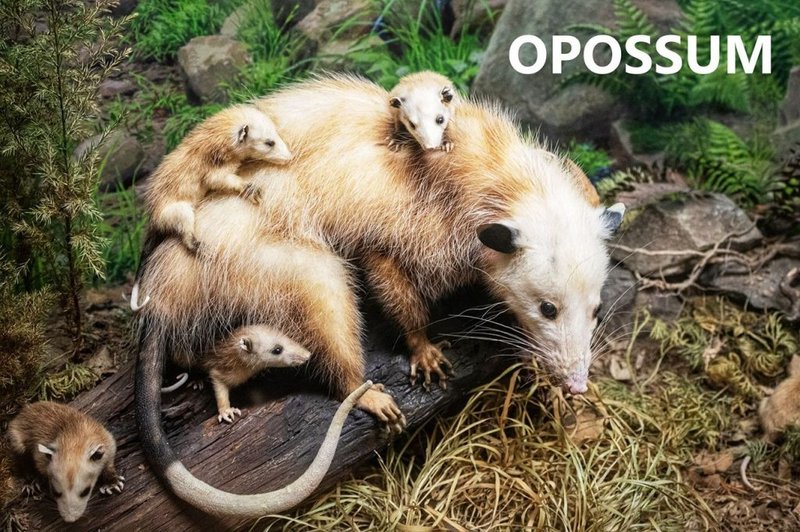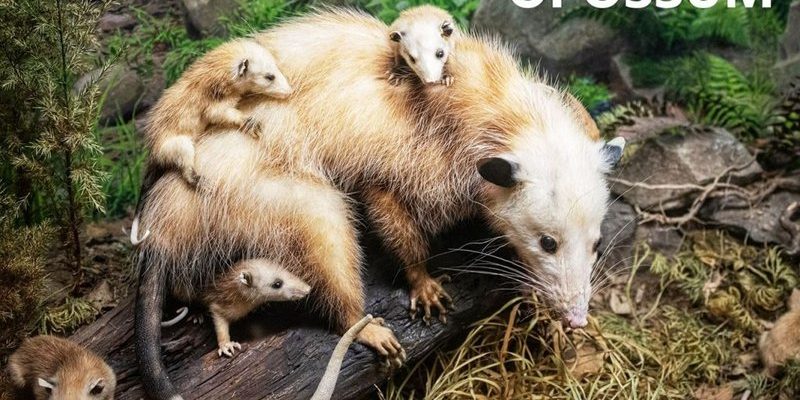
Now, imagine you’re walking through a park or forest. You notice some cute critters nearby, and you can’t help but wonder what they are. While opossums are fascinating, they’re not the only players on stage. Let’s dive into some of these other animals and learn how to tell them apart from our friend, the opossum.
The Virginia Opossum
Let’s kick things off with the Virginia opossum, the most well-known species. They’re the only marsupials native to North America, and you can usually spot them by their pointed snouts and big, round ears. Opossums are often recognized by their long, hairless tails that resemble small rat tails.
A fun fact about opossums is their ability to play dead when threatened. They’ll flip over, their hearts slow down, and they can stay in this “playing possum” state for hours! This behavior isn’t just for show; it’s a survival mechanism that helps them avoid predators. So, if you see a creature lying still on the ground, you might just be witnessing a master of disguise.
The Sugar Glider
Next up, we have the sugar glider. If you’ve ever seen a small, fluffy creature gliding from one tree to another, it might have been a sugar glider. They’re also marsupials, but unlike the Virginia opossum, sugar gliders are much smaller and have a distinct membrane that stretches from their wrists to their ankles. This allows them to glide gracefully through the air, which is a lot of fun to watch!
While opossums are nocturnal scavengers, sugar gliders primarily feed on nectar, fruits, and insects. If you’re trying to tell them apart, look for the sugar glider’s large, dark eyes and fur that’s often gray or brown, which makes them look quite adorable. They might be similar in their marsupial classification, but they have a very different lifestyle!
The Common Rat
Let’s not forget about the common rat. These little guys might not seem similar to opossums at first glance, but if you see one scurrying around at night, you might do a double-take. Both rats and opossums have long tails, but opossums’ tails are much less furry. Rats also have more pronounced snouts, which can help differentiate them from our marsupial friends.
Rats are known for their intelligence and adaptability. They often thrive in urban environments where food is plentiful. So if you see something with a naked tail rummaging through trash, take a closer look. The rounded ears and bulkier body structure might just reveal that it’s a rat, not an opossum.
The Bandicoot
Now, let’s hop over to the bandicoot, another marsupial but one that’s a bit different from the opossum. Bandicoots have a more elongated body and a narrower snout, which can make them look a bit like a small piglet. They tend to be more agile on land than opossums, which is evident when you watch them dart around in their habitats.
While opossums are typically scavengers, bandicoots are more likely to dig for their food, which includes insects, worms, and even tubers. If you ever spot a creature with a pointy snout digging in the dirt, it’s probably a bandicoot and not an opossum.
The Tasmanian Devil
You might have heard of the Tasmanian devil, especially if you’re a fan of cartoons! These small but fierce marsupials are known for their incredible strength and loud screeches. Though they share a similar body shape with opossums, Tasmanian devils are generally stockier and have a darker fur coloration.
One thing that sets them apart is their unique feeding habits. Tasmanian devils are scavengers, just like opossums, but they tend to target larger carcasses. If you’re trying to differentiate them, pay attention to their size—Tasmanian devils are often much larger and more robust than the Virginia opossum.
The African Pygmy Hedgehog
Then we have the African pygmy hedgehog. While they’re not marsupials, they share a nocturnal lifestyle with opossums. These tiny creatures are covered in sharp quills, which makes them look quite different. If you see something scurrying away and curling up into a ball, it’s likely a hedgehog and not an opossum.
Hedgehogs primarily feed on insects and can often be found rummaging through gardens at night. If you’re trying to tell them apart, just remember that opossums have a more defined face and tail, while hedgehogs have that distinctive spiky coat.
The Raccoon
Ah, the raccoon! With their famous mask-like markings and dexterous paws, raccoons might remind you of opossums, especially when they’re digging through your trash. They’re both opportunistic feeders, but there are key differences. Raccoons have thick fur, bushy tails with rings, and a broader face that make them quite recognizable.
Raccoons are also more social than opossums, often seen in groups. So, if you see a large critter with a happy little face and a wobbly tail, it’s likely a raccoon, not an opossum.
The Porcupine
Moving on, we encounter the porcupine. With their impressive quills and unique appearance, porcupines stand out quite a bit from opossums. They’re larger, have round bodies, and are usually covered in long, sharp quills that they can use for defense.
Unlike opossums, porcupines are herbivores, munching on leaves, stems, and fruits. If you spot a creature climbing a tree, check for those prickly spines! A fluffy opossum doesn’t have those, so you can easily tell them apart.
The Koala
Last, but certainly not least, is the koala. These iconic Australian marsupials are famous for their tree-hugging lifestyle and adorable faces. Koalas have a noticeably rounder body and very fluffy ears compared to opossums. They also spend most of their time eating eucalyptus leaves, unlike opossums, who are more opportunistic eaters.
It’s pretty rare to find a koala outside of its native habitat, but if you do, you’ll see that their gentle demeanor and distinct appearance make it easy to tell them apart from opossums.
As you can see, while many animals share traits with opossums, they each have unique features that help you tell them apart. Whether it’s the playful nature of a raccoon or the quiet gliding of a sugar glider, each creature adds its charm to the animal kingdom.
Next time you’re out and about, keep your eyes peeled for these interesting animals and remember the differences that set them apart from the charming opossum. Understanding these distinctions not only enhances your wildlife observations but also deepens your appreciation for the fascinating world around us!

